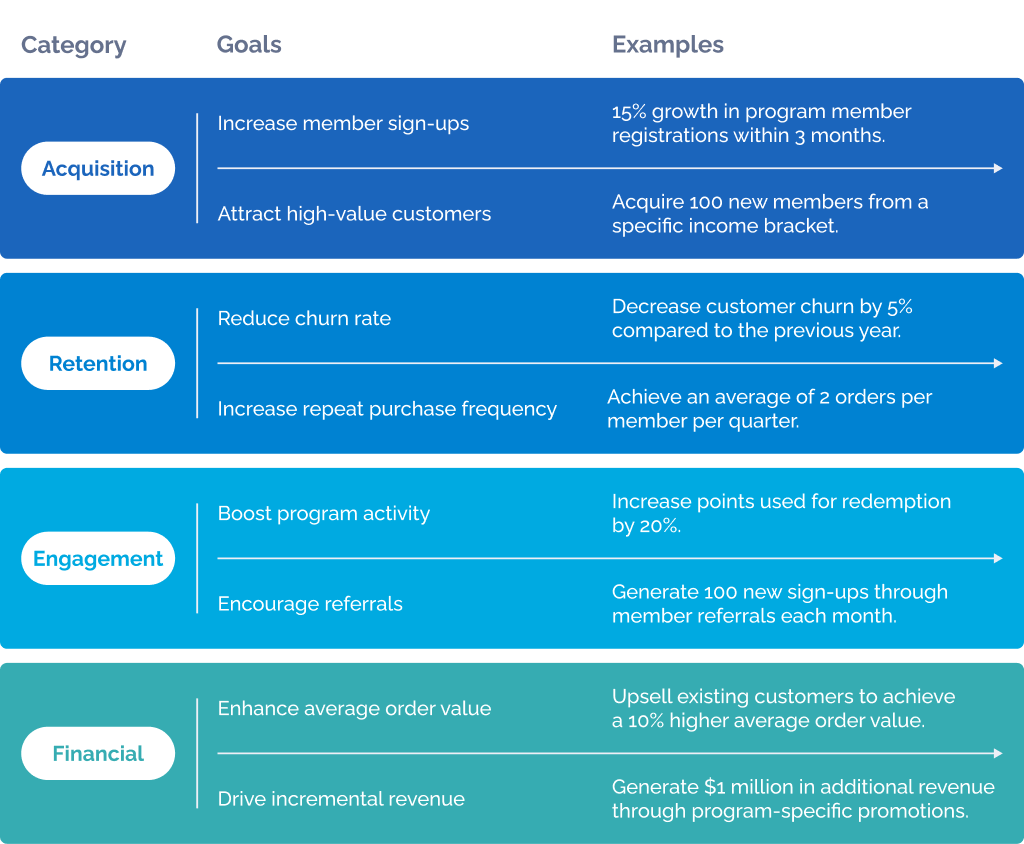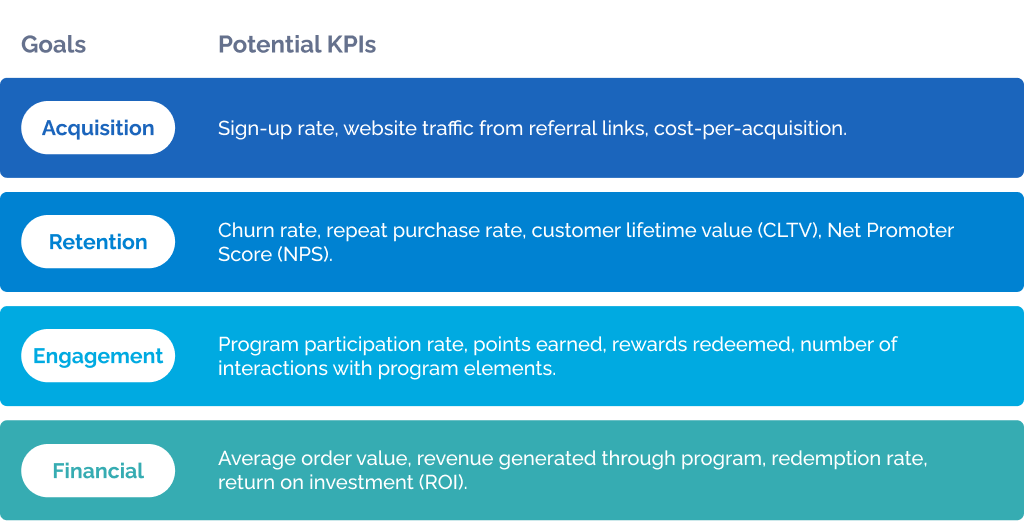Loyalty Launch Guide
How to Launch a Customer Loyalty Program in 6 Easy Steps.
Refer a client who signs an annual contract with Ambassador, and you'll earn up to 20% of the total contract value.
Enroll TodayLoyalty programs can be powerful tools for fostering customer engagement, driving repeat purchases, and boosting brand advocacy. But to reap these benefits, setting and measuring meaningful goals is crucial.
Focus on quantifiable outcomes. Avoid vague goals like "increase customer loyalty." Instead, set SMART goals: Specific, Measurable, Achievable, Relevant, and Time-bound. For example, "Increase repeat purchase rate by 10% within the next 6 months."
Loyalty program goals represent the targets that companies strive to meet through their customer loyalty initiatives. Depending on the business's sector, the characteristics of its products or services, and its overarching marketing approach, these goals can differ. Below are several typical objectives associated with loyalty programs.
Increase Customer Retention: This is perhaps the most fundamental goal of any loyalty program. By rewarding repeat business, companies aim to keep customers coming back, thereby increasing the likelihood of repeat purchases.
Enhance Customer Lifetime Value: Loyalty programs aim to increase the total amount of money a customer spends with a company over the entire duration of their relationship. By encouraging repeat business and increasing the frequency of purchases, companies can boost the lifetime value of their customers.
Boost Customer Engagement: Engagement-focused loyalty programs aim to deepen the customer's relationship with the brand. This can include increased interaction on social media, participation in events, or contribution of user-generated content.
Acquire New Customers: While the primary focus of loyalty programs is often on existing customers, they can also be used as a tool to attract new customers. Referral rewards or benefits that are visible to non-members can entice new customers to join.
Gather Customer Data and Insights: Through loyalty programs, companies can collect valuable data about customer preferences, buying habits, and behaviors. This data can then be used to tailor marketing efforts, improve product offerings, and enhance overall customer experience.
Cross-Sell and Up-Sell Opportunities: Loyalty programs can be used to encourage customers to try different products or services. By offering rewards or points on a wider range of products, companies can increase the breadth of their sales.
Create Brand Advocates: Loyal customers often become brand advocates. A well-designed loyalty program can encourage customers to recommend the brand to friends and family, thus acting as a powerful word-of-mouth marketing tool.
Reduce Marketing Costs: By maintaining a base of loyal customers, companies can potentially reduce the need for extensive and costly acquisition campaigns. Loyal customers are also more likely to respond positively to targeted marketing efforts.
Increase Sales during Off-Peak Times: Some loyalty programs are designed to boost sales during traditionally slower business periods by offering special rewards or incentives during these times.
Improve Customer Feedback and Communication: Loyalty programs can be a channel for direct communication with customers, providing a platform for feedback, surveys, and personalized communication.
Loyalty program goals can usually be placed in one of four categories; acquisition, retention, engagement, or financial as seen in the chart below: 
KPIs, or Key Performance Indicators, are quantifiable measures used to evaluate the success of an organization, employee, project, or activity in meeting objectives for performance. Essentially, KPIs help an organization assess its progress towards its stated goals and are crucial in decision-making processes.
Once your goals are set, it's time to identify the relevant KPIs to track your progress, as demonstrated in the chart below:

Choose the right data collection and analysis tools to monitor your KPIs effectively. Loyalty program software often provides built-in reporting functionalities. Integrate with other data sources like CRM systems for a holistic view.
Track your progress regularly and adjust your program based on data insights. A/B test different rewards, communication strategies, and tier structures to identify what resonates with your audience.
Set realistic goals: Don't aim for overnight success. Start with achievable targets and gradually increase complexity as your program matures.
Communicate goals: Share your program goals with your team to ensure everyone is aligned and working towards the same objectives.
Celebrate successes: Regularly acknowledge and celebrate milestones achieved through your program. This motivates both your team and members.
Embrace experimentation: Don't be afraid to try new things and learn from mistakes.
Continuous improvement is key to maximizing your program's potential. By setting clear goals, choosing relevant KPIs, and actively monitoring your progress, you can ensure your loyalty program drives desired outcomes and become a valuable asset for your business. Remember, data is your guide – use it to refine your program, build stronger customer relationships, and achieve lasting success.
These referral marketing statistics tell a compelling story on how to acquire new customers to drive business growth by leveraging recommendations.
By 2020, U.S. affiliate marketing spend is expected to rise to $6.8 billion. For successful affiliate management, relationship building is crucial....
With automated affiliate marketing, your brand can easily create a repeatable process to continuously attract new and loyal customers. Here are five...
Sign up for our Ambassador newsletter and get notified when we publish new
eBooks, case studies, blog posts and more. It's like a crash course in referral
marketing - and it's free. Plus, we promise not to spam you.
Platform
© 2024 i2H Inc. All rights reserved | Privacy Policy
© 2021 Kalungi, Inc. - All Rights Reserved.
Powered by Atlas - a B2B SaaS HubSpot theme